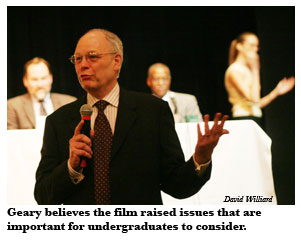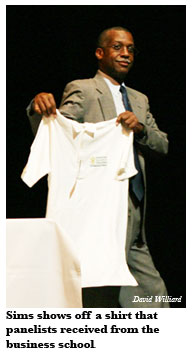'Who Killed the Electric Car?' debated
 During the early 1990s, in response to a
California mandate, General Motors (GM) produced a viable electric
vehicle (EV1) that met the requirements of the state’s zero-emissions
policy mandate. As soon as the mandate was withdrawn, GM killed the
vehicle.
During the early 1990s, in response to a
California mandate, General Motors (GM) produced a viable electric
vehicle (EV1) that met the requirements of the state’s zero-emissions
policy mandate. As soon as the mandate was withdrawn, GM killed the
vehicle.The documentary film “Who Killed the Electric Car?” that recently was screened by the Mason School of Business to a full house at the Kimball Theatre seeks to cast blame for the decision that left Americans with no alternative to automobiles that operate on petroleum-based products. The film points an accusatory finger toward an auto service industry that stood to lose billions if electric cars were successful, toward oil companies concerned that their monopoly on fuel would be threatened and toward politicians in California who ultimately sided with corporate interests in removing the zero-emissions mandate. In the end, the filmmakers suggested that these and others, including U.S. consumers, were complicit in the vehicle’s demise.
After the screening, a panel of faculty experts considered both the style and the substance of the film. Generally, they found the documentary’s artistic devices, such as a mock funeral on behalf of the cars by former leaseholders and the assembly of a virtual posse of EV1 enthusiasts to track vehicles until they were committed to huge crushing machines, entertaining. The film, however, left many pertinent questions unanswered, they agreed.
James Bradley, associate professor of business and a former GM executive, suggested that corporate mistrust between Saturn, the manufacturer of the EV1, and other divisions within GM may have worked against the vehicle. Officers of the other divisions might have felt threatened by the success that Saturn could have enjoyed, he suggested. In addition, he pointed out that GM does not make money on small vehicles, so producing a successful electric car could, in fact, have worked against the company’s interests.
 Robert
Hicks, associate professor of economics, suggested that the film misled
its audience insofar as it suggested that electric vehicles had no
negative impact on the environment. There is a cost to producing
electricity, he said. He felt the film did a good job of pointing out
the tension between the marketplace and government regulations.
However, the EV1, at the time it was being produced, might not have
been as attractive to consumers as the film had indicated because of
the relatively cheap access to gasoline in the United States, he said.
Robert
Hicks, associate professor of economics, suggested that the film misled
its audience insofar as it suggested that electric vehicles had no
negative impact on the environment. There is a cost to producing
electricity, he said. He felt the film did a good job of pointing out
the tension between the marketplace and government regulations.
However, the EV1, at the time it was being produced, might not have
been as attractive to consumers as the film had indicated because of
the relatively cheap access to gasoline in the United States, he said.Among the other panelists, Tonya Boone, associate professor of business, said the EV1, as portrayed in the documentary, seemed to “harness the passion of consumers.” Certainly the leaseholders who were featured were “almost proselytizing once they learned about the fate of their cars,” she said. She also was struck by the fact that the viability of the car was tied to improvements in battery design initiated at the “grassroots” level. Todd Mooradian, associate professor of business, agreed with the premise of the filmmakers that GM was not acting in its own best interests by pulling the car from the market. If it had been, it would have continued to develop the technology that placed it in a leadership role in the area of vehicles that did not require gasoline. Mooradian, however, suggested that lack of consumer demand, despite the film’s assertion that the vehicle had long waiting lists of buyers, may have played a key part in the EV1’s demise. “At some point, you can blame consumers for their failure to act collectively to get the government to act in their interests,” he said. For his part, Ronald Sims, the Floyd Dewey Gottald Sr. Professor of Business, said everyone was to blame. “I believe it was a conspiracy,” he told the audience.
After the event, several panelists extended their comments concerning the discussion raised by the film, including whether or not the car was killed via a conspiracy. Bradley reasoned against that premise. “I don’t know, myself, the proper definition of a conspiracy, but I don’t think that all of the parties coordinated to kill this thing,” he said. “I think each party was acting on what it thought was its own myopic interest.”
He continued, “The twist here, at least for GM, is that maybe their response in their decision framework seemed rational.” As a professor who teaches about operations management, he hoped his comments helped audience members realize that “things don’t always happen rationally within corporations. Organizations are sometimes—maybe often—dysfuntional and behave in ways you might not expect,” he said.
Hicks said that the film encouraged viewers to think about the interface between regulation and business. “My advice was that it may not be best to kind of let the government pick and choose which kind of technology is going to rule the day two, three or five years from now,” he said. The California mandate that manufacturers produce 10 percent of their vehicles with zero-exhaust emissions by a fixed date was arbitrary, he suggested. “I question whether people would be willing to have a new family car that could go maybe four hours on a charge but then they would have to stop and charge it for hours. It’s really not in the consumers’ interest to purchase that car,” he said.
Sims maintained his assertion that a conspiracy killed the vehicle. “How can there not be a conspiracy? I mean, how did the stars line up unless people in powerful positions get together and make these decisions?” he asked. “Heck, they don’t even need to get in the same room. The oil companies, the auto makers and certain government officials share common interests.”
Sims added that consumers also contributed to the death of the vehicle. “It’s kind of like we all conspire if we don’t take a stand, if we don’t hold industries or government accountable. The conspiracy is to keep us dependent on oil. The big boys and girls making money in oil are not going to give it up without a fight.”
William Geary, assistant dean in the business school, praised all those involved for extending the dialogue. “The event was focused on the 180 students who were just admitted to the business school,” he said. “They had a chance to look at the documentary from the point of view of ethics, sustainability, change management—there were many aspects.” Although he agreed that the film was stronger on circumstantial arguments than on factual arguments, it provided these students with “food for thought,” he said.
 Skip to main content
Skip to main content
